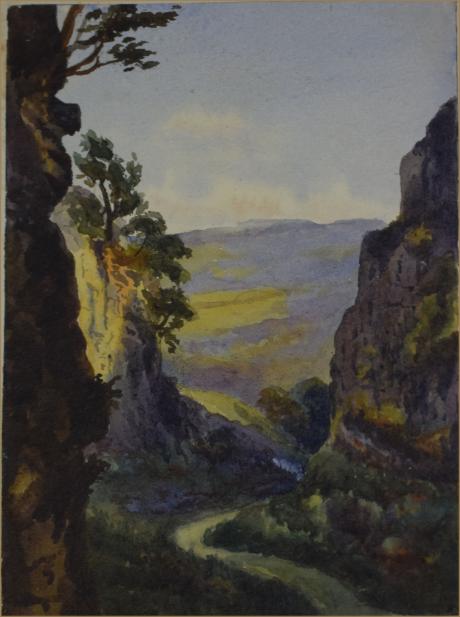inscribed and dated and signed with house guests signatures " 1893 / August 8th 21st / Francis Jay Thomas/ Bepie S Farrer, Harry Fletcher, E A Di Hibbert/ John H Monckton, J A Farrer, Christopher F Roundell, Ralph Payne , Minna Farrer Flora Meynell Pack Frank Farrer W Brodrick Thomas Percy J Hilehut Lucy J Thomas."
Trow Gill is a wooded limestone ravine at the head of Clapdale near Clapham in the heart of Yorkshire's "Three Peaks" limestone country.
Now a dry gorge, Trow Gill was possibly once an underground cavern formed by waters which now take an alternative route through the Ingleborough Cave / Gaping Gill system. At some point in time the roof of this cavern is believed to have collapsed - Trow Gill being the suggested result (though other theories have the ravine as simply a glacial meltwater channel). The South East slopes of Ingleborough are more gentle than those of the west - with a gradual approach to the summit that passes a host of internationally important karst features. Trow Gill is a classic example of an abandoned meltwater gorge, and is easily accessible from Clapham. Some 14000 years ago, during the last glaciation, all the major sinks on the limestone plateau beneath Ingleborough were frozen up, and blocked by glacial debris. As the ice began to melt, over thousands of years it formed a torrent that moved over the frozen land, seeking a place to escape and finding a major joint of weakness which it gradually eroded into this famous landscape feature.
Even today you can imagine that, at any minute - a great torrent is going to roar down there and sweep you off your feet. The dry waterfall is an exciting scramble, bringing the explorer as close to the bare bones geology as it's possible to be. Notice how swirling water has picked out a bedding plane on the left of the picture to form this small cavern - 'the devil's kitchen.' It's a great spot, by the way, for shelter and refreshment, with its own 'kitchen table' formed by a boulder that has fallen from the ceiling.
Similar weaknesses in the Great Scar limestone have been exploited by the meltwater torrent as we look down the gorge from above, where the early stages of developing caves can be seen on the left.
There has been some dispute by geologists as to whether Trow Gill was at one time a cavern itself, and that the boulders underneath the moss on the right represent a section of collapsed roof. This theory is nowadays rejected in favour of the gorge having always been an open meltwater channel. All of the limestone seen here originated from corals and tiny sea creatures that lived in a warm shallow sea some 340 million years ago. The two huge bedding planes in the cliffs on the left (one terminating at the devil's kitchen and one at top left) indicate periods of time when there was a lull in deposition of limestones - probably a result of falling sea levels. Often in these situations, muds washed into the very shallow sea formed shales which can be picked out in the bedding plane. The main 'wall' of limestone at left centre, above the cave, represents an immense time period with more or less constant sea levels where limestone formation continued without interruption for millions of years. Altogether the band of Great Scar limestone around Ingleborough is about 800 feet thick - so here we are looking merely at the top 200 feet or so. This means that, beneath the path, there is still another 600 feet of lovely white rock before we meet the basement rocks underneath - though this can vary owing to the undulating surface of the ancient basement. Little wonder then, that this wonderful mountain has so many caves to explore. Water hitting limestone always finds a way in - and a way out!
In this area is Body Pot, where, in 1947, the fully clothed corpse of a man with shaving gear, coins and a bottle of cyanide was found. Had he been a German spy who, once discovered - had taken his life? It remains one of the great human mysteries of the Three Peaks.

